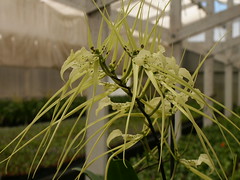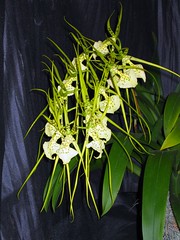Do you think spiders are really cool? Then consider growing your own spider–spider orchid that is, genus Brassia.
Even if you don’t like spiders, you’ll love the Brassia orchid. It’s a beautiful, aromatic flower with long, slender “spider-leg” sepals. The upper petals are a light-yellow green and the lower sepals are creamy with a hint of rosy red. Maroon markings ring the blossoms and the lip, which is nearly translucent and resembles a pointy chin.
The Brassia orchid is native to the wet forests of tropical Central and South America and is named for a 19th century, British botanical illustrator, William Brass. The spider-like look of Brassia orchids gives this plant a distinct propagating advantage. To certain parasitic wasps these flowers resemble spiders in a web, so the wasps lay eggs on the “spiders”, which are really the interior of the orchid’s blossoms. It’s a win-win situation. The wasps reproduce and the orchid gets pollinated.
Brassia orchids can be cultivated outside the tropics as long as specific growth requirements are met. Give your “spiders” high humidity (50 to 70%) and bright, non noon day light. Bright and diffuse light is perfect for these orchids.
Pot your “spiders” in a mix of charcoal, peat moss, perlite and medium bark. Water regularly, particularly during their growing period (usually spring and summer). Brassia orchids produce pseudobulbs during this time, which are used to store energy for the plant. These pseudobulbs possess one to two flat, elongated leaves, and both leaves and pseudobulbs grow straight up. Brassia plant can measure from 1 to 2 feet long, from pseubulb to leaf tip.
A spike emerges from the base of each pseudobulb which produces between 8 and 12 blossoms. These blossoms are usually around 3 inches in size and bloom alternately up the spike.
Brassia orchids need a lot of water while producing flowers, but don’t like to get too wet. Good air circulation is important, too, otherwise you will see brown spots on the leaves. A small fan can be used to facilitate circulation, but never let the fan blow directly onto the plant. Daytime temperatures should remain between 65 and 75 degrees Fahrenheit. Night time temperatures are only slightly cooler with a range of 55 to 65 degrees.
Creating beautiful flowers uses up a lot of energy, so, much like an athlete after a big game; Brassia orchids need to take a break after their growing period. At that point temperatures need to remain at the lower end of the 55 to 60 degree range. Less watering is required, perhaps as little as once a week, but don’t let the pseudopods or leaves dry out.
Take good care of your Brassia orchids and when summer arrives, you will be rewarded with dozens of fragrant and stunning blossoms. You can show them off to friends and family, or simply sit back and admire your handiwork. Either way, Brassia orchids won’t disappoint.
Happy growing!


